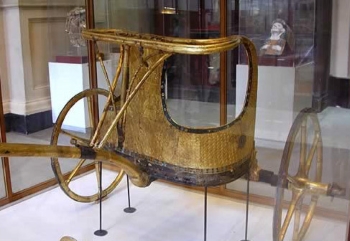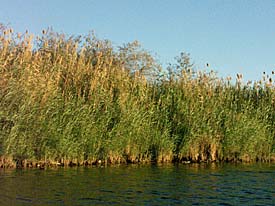
 |

 |
When it came to the attention of Par•ohꞋ that Bᵊn•eiꞋ-Yi•sᵊrâ•eilꞋ was bivouacked in the northwest corner of the Sinai peninsula, boxed in by Yâm Suph, Mi•dᵊbârꞋ Shur•âhꞋ, he had a change of heart about them, exclaiming, "What have we done, sending Yi•sᵊr•â•eilꞋ from our service?!?"
So he harnessed his chariots![]() and his am and took them with him; 600 of his best chariots of all Mi•tzᵊraꞋyim, each chariot manned by a driver and two swordsmen-archer fighters, one of whom was the chariot commander.
and his am and took them with him; 600 of his best chariots of all Mi•tzᵊraꞋyim, each chariot manned by a driver and two swordsmen-archer fighters, one of whom was the chariot commander.
So the Mi•tzᵊraꞋyim armored corps and mounted cavalry came into view on the horizon as they were encamped by ha-Yâm at Pi ha-Khir•ōtꞋ, in front of BaꞋal Tzᵊphōn.
When Bᵊn•eiꞋ-Yi•sᵊrâ•eilꞋ looked up and saw the whole Mi•tzᵊraꞋyim Army on the horizon headed toward them they were terrified and cried out to é‑‑ä, defiantly mutinying against Mōsh•ëhꞋ, shouting that they had been better-off in Mi•tzᵊraꞋyim.
Then Mōsh•ëhꞋ told the am, "Don't be afraid! You stood up to them before, and you saw the yᵊshu•âhꞋ of é‑‑ä – which He'll do for you today. For whereas you've seen the Mi•tzᵊraꞋyim today, you won't see them anymore, ever. Shall é‑‑ä do the fighting for you while you plow the contingencies?"![]()
 sekhem (r) 0350x297.jpg) |
“Why are you crying out to Me?
Speak to Bᵊn•eiꞋ-Yi•sᵊrâ•eilꞋ instead, that they bug-out! Raise your staff! Stretch-forth
your arm over ha-Yâm!
Blaze a trail through it so Bᵊn•eiꞋ-Yi•sᵊrâ•eilꞋ may caravan through it on solid
ground.
"Look, I'm goading the heart of Mi•tzᵊraꞋyim and they will come after the Israelis. Thus, I will instill respect in Par•ohꞋ and in all of his warriors and his armored corps
and his cavalry
and they shall know that I am é‑‑ä!”
After night had fallen, the ma•lᵊâkhꞋ é‑‑ä, who had been walking in front of the column of Israelis, moved to the rear of the column – transferring the ma•khᵊt•âhꞋ from the front of the column to the rear of the column – between the Mi•tzᵊraꞋyim camp and the Israeli camp. Thus, in the darkness, neither camp could see past the bright fire into the other's camp. Millennia before the invention of night-vision technology, armies usually chose not to fight at night. And so the two camps didn't approach each other all night.
But, masked behind the curtain of light imposed by the ma•khᵊt•âhꞋ, Mōsh•ëhꞋ stretched-forth![]() his arm signaling the Israelis to cross Yâm Suph along a marshy land bridge strip of reeds threading between two large lakes; so that the lakes served as a barrier guarding each flank.
his arm signaling the Israelis to cross Yâm Suph along a marshy land bridge strip of reeds threading between two large lakes; so that the lakes served as a barrier guarding each flank.
The Mi•tzᵊraꞋyim weren't aware of Israel's movement until they saw the ma•khᵊt•âhꞋ moving out across the Yâm Suph marsh – not realizing that this was the very last remnant of Israel's rear column leaving, not the front of the column just beginning to move out as they assumed.
 |
| Yâm Suph |
Knowing that the marsh would slow the Israelis fleeing on foot, Par•ohꞋ, with his much faster horse-drawn chariots, saw no urgency. Hours passed by the time the Mi•tzᵊraꞋyim – millennia before phones and radios – had alerted all of their warriors, mustered them out of their tents, completed their morning toilet and breakfast, strapped on their swords, harnessed up their horses to their chariots, formed up their cavalry formation and finally headed out into the marshes of Yâm Suph in pursuit. By that time, dawn had broken, hours after even the last contingent of the Israeli camp had bugged-out — and the tide was rising. Sloshing![]() through the marsh all night, the last Israeli contingent, carrying the ma•khᵊt•âhꞋ now visible in daylight by its smoke, had already emerged from the far side of Yâm Suph – near the coast in northwestern Sinai.
through the marsh all night, the last Israeli contingent, carrying the ma•khᵊt•âhꞋ now visible in daylight by its smoke, had already emerged from the far side of Yâm Suph – near the coast in northwestern Sinai.
All throughout the night, the rear contingent of Israelis had peered over their shoulders, around the ma•khᵊt•âhꞋ through the column of fire and smoke-cloud, trying to see any approaching Mi•tzᵊraꞋyim soldiers. As first streaks of sun pierced through the night clouds, the Israelis began to make out the figures of the Mi•tzᵊraꞋyim, soldiers struggling for their lives, drowning amidst chariots hopelessly mired and abandoned, the horses flopping in the water like fish in too-shallow water, trampling soldiers underwater, as their chariots and rigging dragged them all beneath the high tide waters that flooded the marshes.

Optional parental preparation:
Discussion: What is the difference between tolerance, courtesy, PC (political correctness) and respect? Civilization, ethnicity, race, culture and religion?
éÌÇáÌÈùÑÈä in 14.16, 22 & 29 – as well as in Yᵊho•shuꞋa 4.22 – equates to çÈøÈáÈä in 14.21 – and in Yᵊho•shuꞋa 4.18.
Artscroll editors honed the meaning, in Biblical times, of çÈøÈáÈä by its contrast, in wa-Yi•qᵊr•âꞋ 26.31, with the term ùÒÈîÇí.![]() .
.
Thus, these describe ground or land that is often wet or flooded by tide or season, but, due to tide, season or damming, have become temporarily wadable-to-dry.
Note, especially in the case of the crossing of Nᵊhar Ya•rᵊd•einꞋ (Yᵊho•shuꞋa 4), that, in the late summer (dry) months, temporarily damming the nᵊhar near Yᵊri•khoꞋ is not difficult.
Note, too, that "as soon as the ko•han•imꞋ stepped out onto çÈøÈáÈä" (loc. cit.), then pulling the plug on the temporary dam would immediately cause the water to flow again.
Note further that total credit is deferred to é‑‑ä with no mention of them building, or releasing, a dam. Modern, scientific, man should also follow that paradigm.
Compare and contrast these terms with the primary synonyms referring to (dry) land:
What is chariot / horses leather harness "rigging"?
Questions you might anticipate that your child might raise and be prepared to discuss:
What does "bug out" mean?
What does "bivouacked" mean?
What were/are the armored corps and mounted cavalry?
What is the horizon?
What is defiance, defiantly?
What does "plow" and "contingency" mean? (see also note in text) What is a contingent?
Before the modern inventions of the PA (public address), telephone and radio, why were visible signals better than audio? What was the difference between communications during the day versus at night?
What does it mean to "blaze a trail"?
What does "goad" mean?
What does "instill" mean?
What is a "column" of people? Smoke?
![]()
 |
 |